Corrosion is a fact of life. From the factory to the flight line to the MRO hangar aircraft manufacturers, operators, and maintainers aim to manage it so that airplanes can fly as safely and as long as possible.
According to the latest report from LMI, the U.S. military’s corrosion cost tracking contractor, the U.S. armed forces rang up an estimated $10.2 billion in corrosion costs for their aviation and missile fleets during FY2016. (That’s just over $1 billion for the Army, $3.4 billion for the Navy/USMC, and $5.7 for the USAF.) The metric is crude since it doesn’t distinguish aircraft from missile corrosion costs. But it tells us corrosion is an expensive problem.
Corrosion is a readiness as well as an airworthiness and safety issue. The more time an aircraft has to spend at the depot, the less time it’s available for operations, says Randy Boatwright, action officer for the Corrosion Prevention Team at the Naval Air Warfare Center Aircraft Division (NAWCAD).
Naval aviation endures a constant barrage from sea water; and the continuous cycle of humidifying and dehumidifying salt attacks the surface of the airplanes. These factors accelerate the rate of corrosion, explains Dane Hanson, future readiness lead for the organization’s Corrosion Prevention Team.
The military—with its greater challenges and advanced engine technologies—tends to drive lubricant development faster than the commercial market does, says Ed Barnes, a global field engineer with ExxonMobil’s Aviation Lubricants Group. So, demands for new requirements will show up in the military market first.
Interiors as well as exteriors are susceptible. Moisture may accumulate through condensation, leakage from fuel systems, and even spills in the galley area. Mark Pearson, operations manager for Lear Chemical Research Corp., recalls an 18-month-old regional jet whose main floor beams had to be replaced because of spills from the forward galley and condensation. Orange juice, coffee, club soda, and tomato juice, for example, can find their way into aircraft interiors and start corroding any metal they come in contact with. Other areas to watch are the leading edges of wings, where paint can start to peel back, notes Julie Voisin, aerospace global marketing manager for Sherwin-Williams Aerospace Coatings.
Eco-Friendliness
NAWCAD supports minimizing the use of hazardous materials, Hanson says. This includes heavy metals – such as chromium and cadmium — that traditionally have been used in primers, as well as volatile organic compounds (VOCs).
The organization, for example, has minimized the use of hexavalent chromium in pre-treatments, Hanson says. Its researchers developed a more environmentally friendly pre-treatment using trivalent chromium, instead. (A pre-treatment is a coating that prepares the surface of a metal before the application of a primer to increase the adhesiveness of the primer.)
Hexavalent chromium has been used for decades on account of its high-performance corrosion protection for a wide range of metals such as aluminum, magnesium, and steel. Moreover, “when a coating is damaged, … expos[ing] the base material, the solubility properties of the chromates allow them to migrate to the exposed area and inhibit corrosion,” according to serdp-estcp.org, a web site devoted to DoD environmental programs.
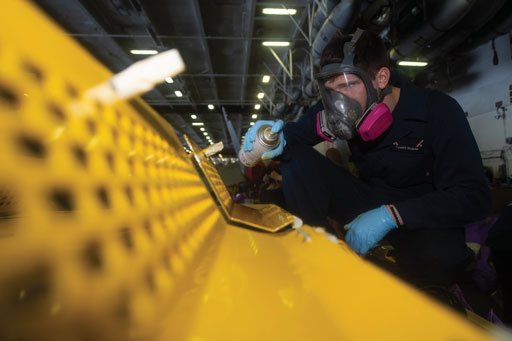
NAWCAD also is trying to communicate corrosion findings in the field to users and operators, Hanson says. Under the organization’s “focus area list” concept maintainers at the Fleet Readiness Centers “identify their priority areas, based on the amount of depot rework involved.” When NAWCAD looked at that data across the fleet, it homed in on priority areas such as mold and mildew growth.
The Commander, Fleet Readiness Center (COMFRC) recently implemented an Aircraft Delivery Deficiency Report (ADDR) to help squadrons improve the “quality and material condition of their assigned aircraft,” explains Jovito Wilson, a deputy IPT lead with COMFRC. The ADDR documents deficiencies associated with inadequate periodic maintenance found by depot-level aircraft examiners during rework, modification, periodic maintenance intervals, and integrated maintenance concept/program or long-term storage where the depot has accepted custody of the aircraft, he says. Among other things, the ADDR includes “detailed descriptions of material condition [and] corrosion discrepancies.” The ADDR process helps to resolve root causes of deficiencies and potentially to improve corrosion management.
A larger effort to “reinstitutionalize corrosion across the fleet” involves training and in-service engineering. NAWCAD, for example, is working on a corrosion informational video aimed at the front-end of programs, where materials and coatings are selected, Hanson says. When it’s completed, this “YouTube video on steroids” will be posted on the DoD public web site, corrdefense.org, he adds.
Black Hawks
Corrosion is also an issue with the Army’s UH-60L Black Hawks. According to LMI, the 806-strong fleet was the No. 1 corrosion cost driver for Army aviation in FY2016, coming in at $244 million.
Sikorsky, which advises the Army on the issue, has built a lot of lessons learned from the L model into the UH-60M, says Chris Dowse, the company’s director of Army programs. The area where the transmission attaches to the airframe, for example, was reshaped to eliminate a small pocket where water could collect. And polyurethane gel gaskets are being used to seal grounding points and protect areas such as antenna placements.
Sikorsky uses high-speed machined airframe components in place of some traditional sheet metal airframe components. This reduces metal-to-metal mating surfaces prone to crevice corrosion and dissimilar-metal fasteners where galvanic corrosion can attack the airframe. Sikorsky “realized an approximately 50 percent reduction in the number of rivets for those assemblies changed from riveted sheet metal details to machined one-piece details,” Dowse says.
The OEM also notes the introduction of Cor-Ban 35 on the interior of the UH-60M airframe and the subsequent use of the compound for the UH-60L, as well. The company also employs an “inhibiting polysulfide sealant” on the UH-60M and for spares supporting the UH-60L aircraft. As a result of such efforts, the Army has reported improved corrosion scores from its Airframe Condition Evaluation inspections database, he adds.
The Army also emphasizes educating maintainers to increase knowledge at the unit level. The Army Aviation and Missile Command (AMCOM) Corrosion Program Office, for example, has partnered with the Utility Helicopter Project Office “to field an interactive 90-day corrosion control inspection video that instructs maintainers on the proper inspection and corrosion preventative compound application details, best practices, and visual instructions that they can’t get from their technical manuals alone,”says Courtney Guasti, AMCOM corrosion program manager.
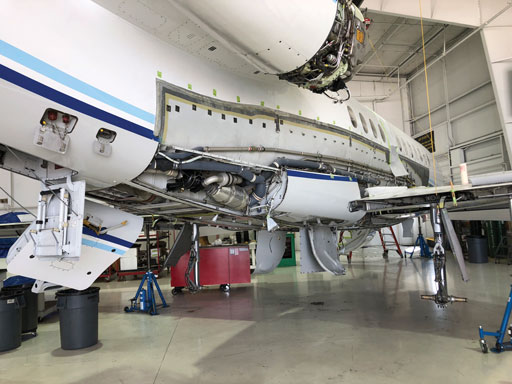
its corrosion risks according to Julie Voisin at Sherwin-Williams. Image by Joy Finnegan.
CPCs and CICs
Among the products that address the problem are corrosion prevention compounds (CPCs), corrosion inhibiting compounds (CICs), combination CPC/CICs, and greases and engine oils with corrosion-inhibiting additives. CPCs – waxy or resin-based — are typically applied to a new metal surface before an airplane has been delivered, Pearson says. CICs, by contrast, are “active” chemistries, intended to penetrate into areas that may already have corrosion, he adds. Lear’s ACF-50 performs both functions, he says. (The terms CPC and CIC, however, are frequently used synonymously, and CPC can also stand for corrosion prevention and control.)
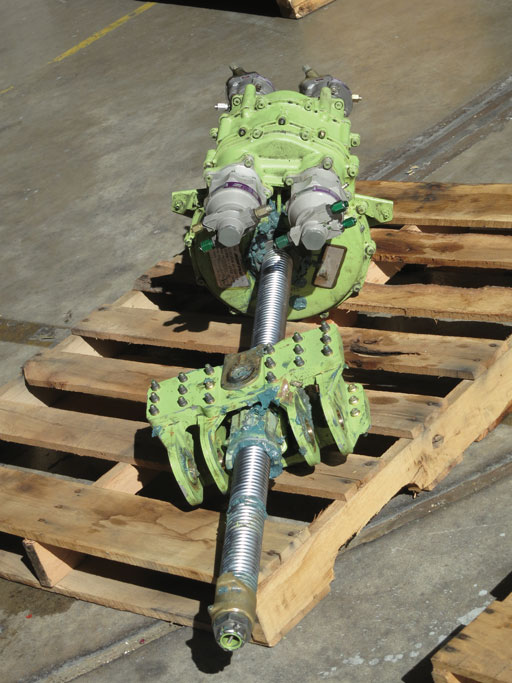
First brought to market in 1985, ACF-50 is one the longest-used aviation anti-corrosion products. A liquid, it can be “fogged” into airframe cavities, covering all the metal surfaces with a very thin film, Pearson says. When this “dense fog” settles, it leaves small droplets on the surface that spread out horizontally and vertically – via capillary action – to form a complete layer. Over a two-year-plus life-span period, the compound slowly evaporates, “leaving virtually nothing behind.”
Cor-Ban
Zip-Chem provides multiple products under the trade name, Cor-Ban, for “ban corrosion,” says Jason Smith, R&D Lab manager and technical support director. The company tailors them to various areas and applications. Some dry to a film; others are waxy and semisolid, and are used for their lubricating properties.
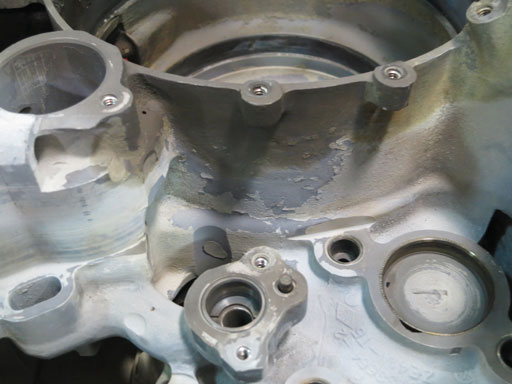
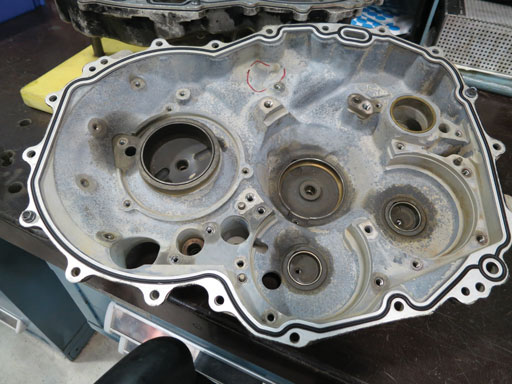
Zip-Chem products are used by Boeing at the factory level on all the aircraft it manufactures except for the 737, Smith says. Boeing also uses Cor-Ban 27L, a non-drying paste, in cavity areas as well as other applications which historically have been protected with a chromate-filled paste.
Cor-Ban 35 can be used inside the wings and fuselage and is removeable with mineral spirits. When used in the interior of an aircraft, it dries and becomes tac-free within an hour, the company says. Typically, Cor-Ban 35 films will last three to five years in corrosive environments, Smith adds. Zip-Chem products are usually applied with spray equipment or as aerosols.
Celeste
Celeste is known for its LPS anti-corrosion products. LPS 1 is a light-duty, water-displacing lubricant for hinges, instruments, and electrical contacts and connections, explains Emily Romblad, aerospace market segment manager. The “greaseless lubricant,” typically applied as an aerosol, evaporates into a dry film. LPS 2 is a longer-lasting lubricant used for moving parts such as hinges, flaps, and seat tracks, as well as static areas such as lap joints. The CIC penetrates crevices and displaces moisture.
LPS 3, meanwhile, is a heavy-duty, waxy film corrosion inhibitor for moving parts that may slide, twist, rotate or vibrate, such as landing gear parts, and static water entrapment areas such as fuselage bilges, wing interiors, doors and hatches, and underneath the lav and galley, Romblad says.
Greases and Oils
ExxonMobil’s airframe greases – containing corrosion-inhibiting additives – are used in areas such as flight control actuators. However, since these greases can “migrate” or be washed off by water, they need to be applied on a “fairly aggressive relubrication” schedule, as directed by the OEM, Barnes says. All told, the company’s greases can lubricate – and protect – some 98 percent of airframe grease applications, he says.
The company specializes, among other things, in wheel bearing greases, which have to endure a lot of punishment. In this area there has been a move from mil-spec to non-mil-spec, commercially approved products, where a general-purpose military spec is not a good fit for a particular application. Formulations under the multipurpose grease specification, Mil-Prf-81322G, for example, are “less than ideal” to wheel bearing lubrication, he says.
The problem is that when the wheels are removed – after 100 to 200 landings – there may be very little grease left to protect the bearings. Since the bearings are sealed, grease can’t be reapplied unless the wheel is taken off, usually because of tire wear.
ExxonMobil offers a longer-lasting, non-mil-spec aviation grease, Mobil Aviation Grease SHC 100, which the wheel bearing and landing gear manufacturers have approved “by name,” based on their testing and experience, Barnes says.
The U.S. Air Force uses the Mobil Aviation Grease SHC 100 on F-16s and C-130s, among other airframes, he says. The USAF found that the older 81322G grease it was using for F-16s was migrating out of the bearings because of high RPMs during takeoffs and landings. “They tried our Mobil Aviation Grease SHC 100 about 15 years ago” and found that it had better adhering properties.
Wheel bearings also have been getting attention, primarily over concerns about the effects of runway deicers. ExxonMobil testing has shown that deicer chemicals such as potassium acetate and potassium formate are just as corrosive as salt, Barnes says. SAE has finalized a new wheel bearing grease spec, AMS 3058, with “higher corrosion protection expectations” than for the Mil-Prf-81322G spec, Barnes says. The company is developing a product that meets the spec.
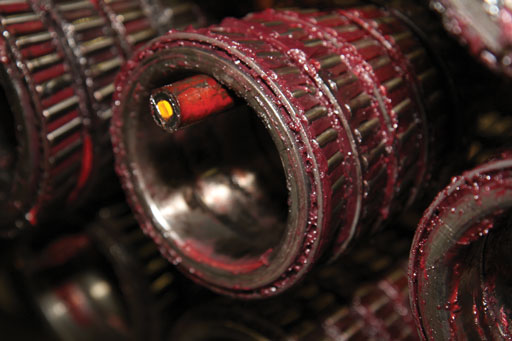
Based on where a grease is used, relubrication may be required as frequently as every 100 hours up to every 600-700 hours. A component like a flight control actuator that is used constantly and is exposed to water and wind would require fairly frequent lubrication.
The company also makes aviation engine oils. With an eye to military problems, the company provides a C/I “corrosion-inhibited” formulation approved under the Mil-Prf-23699 spec for turbine oils, Barnes says.
This is something the Navy and Marine Corps have used for a long time, he says. They were willing to trade some cleanliness and coking performance in order to get enhanced corrosion resistance. That’s acceptable to them because they have such an accelerated and aggressive engine maintenance schedule, he adds.
The military services perform off-wing engine maintenance every 2,000 hours or so, he says. More than that would be a very long time for a military engine to be in continuous service. Apart from the corrosion issue, other factors call for relatively short maintenance intervals. Carrier-based airplanes, for instance, experience highly stressful thermal cycles, landing at full power and then immediately shutting down. This causes coking, a deposition of oxidized oil, to form, leaving a residue in the hottest part of the engine, which has to be cleaned out.
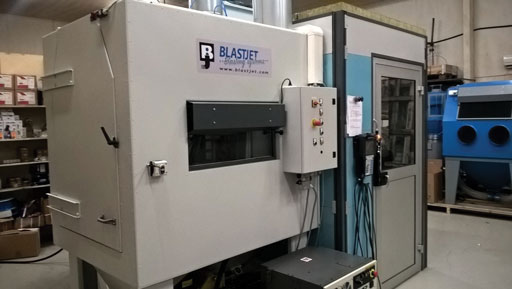
Paint/Blasting
Paint, especially primer, is an essential ingredient in the protective system of aircraft exteriors.
If paint systems are correctly applied, they can last five to seven years, according to Sherwin-Williams. If incorrectly applied, however, the coating can fail and lead to corrosion.
An aircraft’s flying environment, servicing, and method of storage are also important, Voisin says. “Hangaring helps a lot,” she adds. The company also stresses a 24×7 technical service team and bimonthly training sessions that bring in painters and product specifiers from around the world. Although painting is typically one of the last things to do during a service visit, it shouldn’t be rushed, the company says. It’s important, for example, to pre-treat the aluminum so that it’s ready to accept the primer.
Although it’s easy to forget, getting the paint off is just as important as getting it on. Finland-based Blastjet specializes in abrasive blasting systems. It has developed a robotic system for use in wheel and brake shops that removes paint from rims. Employees just load the rim halves and choose the right blasting program, the company says.
